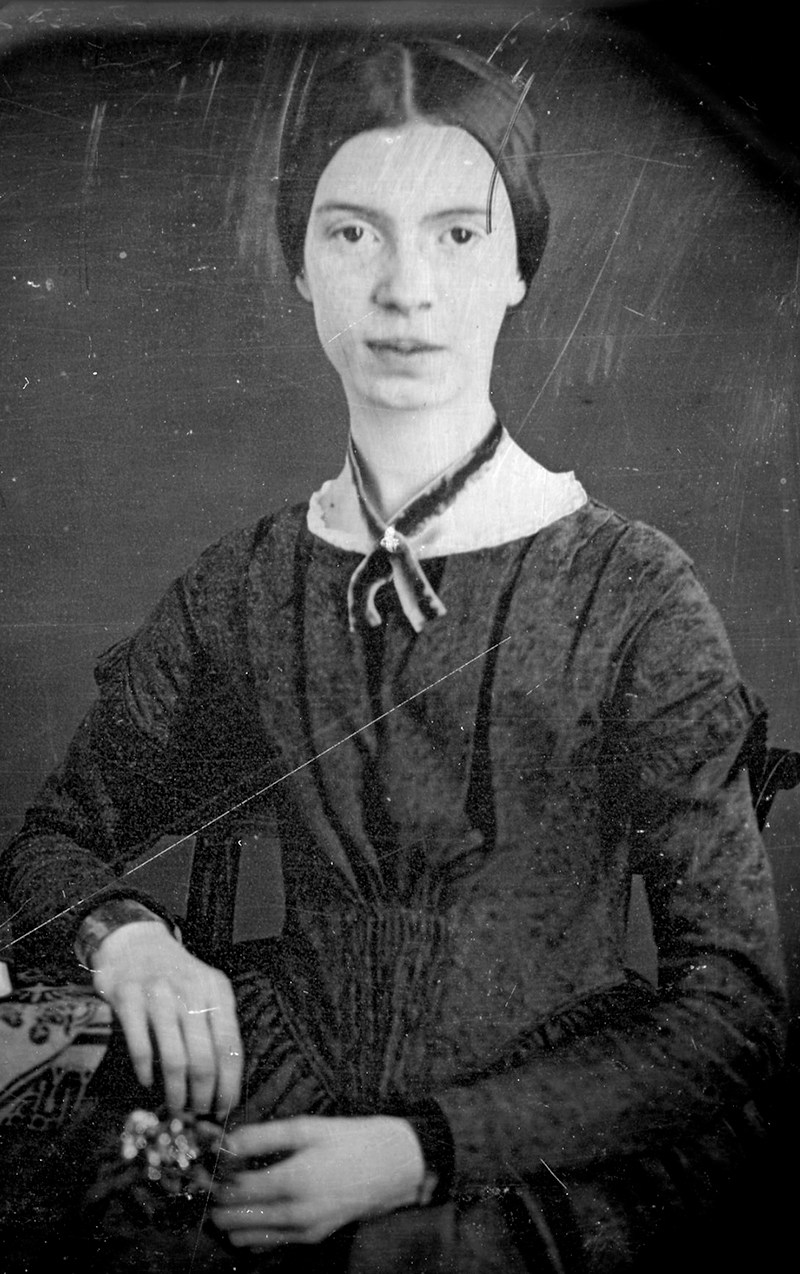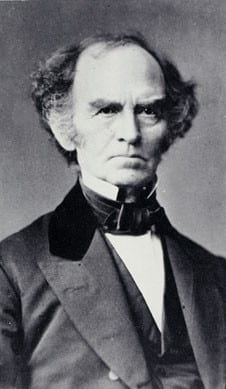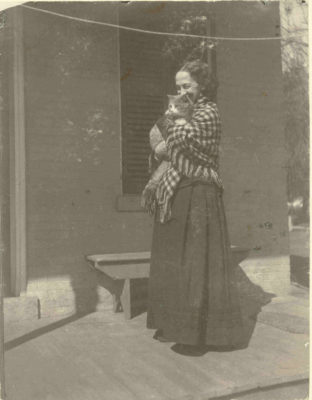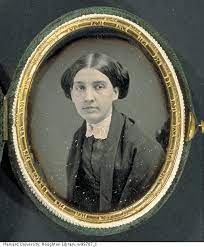Emily Dickinson: The Recluse
March 14, 2022

By: Allie Little
Throughout the nineteenth century, the nation obsessed over male authors like they were rockstars. Men like Poe, Thoreau, and Hawthorne were often seen as brooding, conflicted, and emotionally damaged. They played up a persona of living separate from society or suffering for the sake of their writing. At the same time, the United States had a handful of women authors being published and spread throughout the nation, but they weren’t often granted the fame and acclaim their male counterparts were. Famous American poet Emily Dickinson wrote actively during this time period, but the world never knew of her talent.
Emily Dickinson died at the age of 55 in the same house she was raised in. At the time of her death, only seven of the nearly 1,800 poems she wrote in her lifetime had been published, and all of them were published anonymously. Few people in her hometown of Amherst, Massachusetts knew what she looked like, and her talent for poetry was whispered around town like a local legend rather than applauded and praised. In the town, she was known to only be seen in a white cotton dress on the small occasions she would leave the front door, aiding her ghostly reputation amongst the younger generation. This is the image of Emily Dickinson associated with many of her most famous works, but she wasn’t always this phantom-like figure.
Nearly everything in Emily Dickinson’s life happened in Amherst, Massachusetts. Her family held a level of importance to the town that few others did. Her paternal grandfather was a lawyer, politician, and co-founder of the local Amherst College. Her father, Edward Dickinson, continued the family’s support of the college and was also a lawyer and politician like his father. Edward Dickinson spent a term as a Representative in the United States Congress and later served as part of the Massachusetts State Legislature. His relationship with Emily was often tense but grounded on mutual respect for each other’s intellect.


Being from an influential family, Emily and her siblings, Austin and Lavinia, were taught to prioritize education. Emily excelled as a student at Amherst Academy, and often attended lectures at Amherst College despite women not being allowed to enroll. As seen in her poetry, her brain absorbed information like a sponge. Her areas of interest included chemistry, botany, entomology, astronomy, and various other natural sciences. It was this study of the natural world that helped Emily put into words specific emotions that were difficult to explain in poetry. Explaining death as a fly, as she does in her poem “I heard a Fly buzz - when I died,” made this omnipresent, invisible force make more sense:
I heard a Fly buzz - when I died -
The Stillness in the Room
Was like the Stillness in the Air -
Between the Heaves of Storm -
During the 1840s and 50s, the popularity of Christianity and spirituality expanded throughout the young nation, influencing small communities like Amherst dramatically. The Dickinson family attended church every week and religion played an active role in their schooling. After completing classes at Amherst Academy, Emily left her hometown for a year and went to Mt. Holyoke Female Seminary to continue her education. At the Seminary, all the students would gather for a daily morning assembly where the students answered various religious questions and were assessed by how much faith they possessed. Apparently during one of these assemblies, the adult leading the meeting asked the students to divide themselves into three separate groups:
- Those that have faith
- Those that have hope of faith
- Those with no hope of faith
After each girl selected their group, Emily was the only ‘no hoper.’ According to a fellow student of Mt. Holyoke, Emily commented on the event by saying, “they thought it queer I didn’t rise. I thought a lie would be queerer.”
Assuming this actually happened in the Seminary (according to school records, possibly a total of 30 students ended in the “no hope” category), English scholars often blame Dickinson’s strength of conviction as the reason she considered herself to have no hope in faith. If she thought she didn’t have complete faith, then she felt she had none. Along with her education in science and nature, it was this search of faith that influenced much of Emily’s poetry. Similar to the vague idea of Death, Emily used the natural world to explain her version of faith and spirituality. In her poem “Some keep the Sabbath going to Church,” Dickinson shows how her love of birds, flowers, and nature is how she finds her belief in a higher power.
Some keep the Sabbath going to Church –
I keep it, staying at Home –
With a Bobolink for a Chorister –
And an Orchard, for a Dome –
Some keep the Sabbath in Surplice –
I, just wear my Wings –
And instead of tolling the Bell, for Church,
Our little Sexton – sings.
God preaches, a noted Clergyman –
And the sermon is never long,
So instead of getting to Heaven, at last –
I’m going, all along.
It was after her time in the Seminary that her reclusive habits grew. Leaving Mt. Holyoke marked the end of her formal schooling. Despite her desire to continue her education, this was the time in many young girls’ lives that they would find a husband and take on the role of housewife and mother. Meanwhile, in a letter to a friend, Emily wrote, “God keep me from what they call households.” Clearly not the housewife-type, Emily Dickinson never sought the attention of a man and had seemingly no desire to leave her father’s home to become a maid in another. Instead, Emily spent her time being a mediator and confidant for her siblings and parents.
The Dickinson children were all fairly close in age. Emily was the middle child between her older brother of 1½ years, Austin, and her younger sister of 2½ years, Lavinia. Being the eldest and the only male, Austin was given the most attention by his father and carried the most expectations. He attended Amherst College like his father and grandfather, then Harvard Law School, and had a brief inclination to travel West with his wife, Sue Gilbert. This desire to leave Amherst ended after Mr. Dickinson rejected the idea and offered a partner position at his law firm to Austin. He also gifted the lot of land directly next to the Homestead as a home for Austin and Sue. Emily was often Austin’s anchor to the Dickinson family. Emily believed whole-heartedly in loyalty to family and would often share her brutal honesty with Austin if she believed he was squandering the opportunities placed in his lap.
 Much less is known about Lavinia Dickinson compared to her older siblings. While being the complete opposite to her sister, Emily and Lavinia were incredibly close. Because of Emily’s disdain for household chores, Lavinia was often the one maintaining the Homestead with their mother. Lavinia, often called Vinny, was known for a love of abundance, often overflowing the flowerbeds with various plants, and a love of cats. According to the Emily Dickinson Museum, Vinny would constantly have a procession of cats following her around the Homestead. She, like her sister, never married, but she was noted to have a sharp tongue and quick wit. Since they were children, Emily would often rely on Lavinia’s presence in social situations, as her sister was a much more natural entertainer. Without her sister, Emily preferred to stay in her bedroom rather than entertain new people. After Emily’s death in 1886, it was Lavinia that found the nearly 1,800 poems of her sister’s in a drawer in the poet’s room. Without Lavinia Dickinson, her sister’s work may have been destroyed and never shared with the world.
Much less is known about Lavinia Dickinson compared to her older siblings. While being the complete opposite to her sister, Emily and Lavinia were incredibly close. Because of Emily’s disdain for household chores, Lavinia was often the one maintaining the Homestead with their mother. Lavinia, often called Vinny, was known for a love of abundance, often overflowing the flowerbeds with various plants, and a love of cats. According to the Emily Dickinson Museum, Vinny would constantly have a procession of cats following her around the Homestead. She, like her sister, never married, but she was noted to have a sharp tongue and quick wit. Since they were children, Emily would often rely on Lavinia’s presence in social situations, as her sister was a much more natural entertainer. Without her sister, Emily preferred to stay in her bedroom rather than entertain new people. After Emily’s death in 1886, it was Lavinia that found the nearly 1,800 poems of her sister’s in a drawer in the poet’s room. Without Lavinia Dickinson, her sister’s work may have been destroyed and never shared with the world.
No account of Emily Dickinson’s life could be complete without mentioning Sue Gilbert. Essentially the third Dickinson sister, Sue Gilbert, later Sue Dickinson, was a lifelong friend to Emily. Sue was the social butterfly to Emily’s reclusive nature, and became Emily’s sister in-law officially after marrying Austin Dickinson and taking residence next door at the Evergreens. The two women bonded over literature, with Sue being a lover of reading and a writer herself. Emily trusted Sue so much that she even let Sue give her notes and criticism on her poems, and for the notoriously stubborn Emily Dickinson, that’s a big deal. She also received nearly 250 personalized poems from the poet while living next door. Sue and Emily’s relationship continued until Dickinson’s death in 1886. Following her passing, Sue wrote the obituary for Emily that was published in the Springfield Republican.
One can
only speak of "duties beautifully done";[...]
of her tenderness to all in the home
circle; her gentlewoman's grace and courtesy
to all who served in house and grounds; her
quick and rich response to all who rejoiced or
suffered at home, or among her wide circle of
friends the world over.
-Sue Dickinson

After her father’s passing in 1874, Emily was traumatized by the loss. Her mother suffered a stroke a year later which did nothing to alleviate Emily’s fears. As the mediator of the family, she took on more household chores during the later years of her mother’s life. This slowed the production of her poetry dramatically, and it was after the passing of her father that Emily became the illusive recluse she is known as today. While she stopped attending many social gatherings in her mid-twenties, it was in the late 1870s that she no longer attended the parties Sue would host next door. She thought meeting people was exhausting. She also began to have problems with vision and was rumored to be self-conscious about her health problems. In 1886, Emily Dickinson died in her childhood bedroom, with only a few friends knowing her to be the great writer she was.
There will never be a conclusive explanation as to why Emily Dickinson did not seek fame during her life. Scholars speculate and most widely believe that fame may have seemed distasteful to seek out in a family of such high stature. It’s clear given what we know of her life, that Emily Dickinson wasn’t writing for an audience. As a lifelong student of the world, she wrote poetry to explain things that are, in her eyes, unexplainable. It is thanks to the select few people that loved her, that any of us know how she saw the world at all.
While I’ve added some of Dickinson’s poetry throughout this blog to give examples of her use of specific themes, I wanted to share my favorite poem by the great Emily Dickinson:
If I can stop one heart from breaking,
I shall not live in vain;
If I can ease one life the aching,
Or cool one pain,
Or help one fainting robin
Unto his nest again,
I shall not live in vain.
For more information:
https://www.emilydickinsonmuseum.org/
https://www.poetryfoundation.org/poets/emily-dickinson